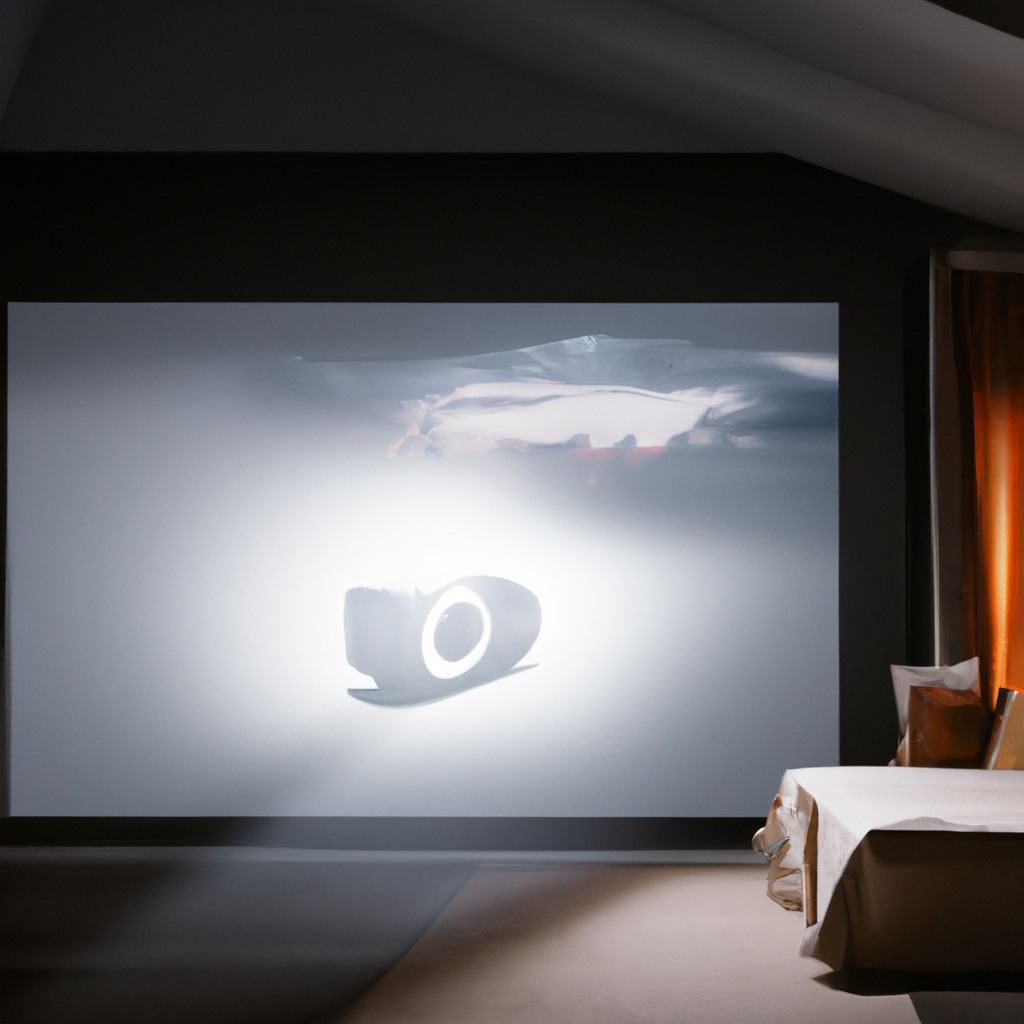Imagine transforming your bedroom into your very own personal cinema, where you can indulge in the joys of movies without leaving the comfort of your own home. With a smart home theater system, you can now bring the magic of the big screen right into your bedroom. By following a few simple steps, you can create a truly immersive cinematic experience that rivals any theater. Get ready for unforgettable movie nights, complete with stunning visuals, crystal-clear sound, and all the comforts of home.

Designing the Perfect Home Theater Setup
Designing the perfect home theater setup requires careful consideration of various factors to ensure an immersive and enjoyable cinematic experience in your own bedroom. From choosing the right location to evaluating seating options, each aspect plays a vital role in creating a space that rivals a traditional cinema.
Choosing the right location
When selecting the location for your smart home theater, it’s essential to find a room or area in your bedroom that provides optimal viewing conditions. Consider the room’s size, layout, and natural lighting. Ideally, choose a room with minimal windows and the ability to control lighting conditions. This will help minimize unwanted glare on your screen and create a more authentic theater-like atmosphere.
Determining the optimal screen size
The screen size is a crucial consideration in any home theater setup. It determines how immersive and engaging your movie-watching experience will be. To determine the optimal screen size for your smart home theater, consider the viewing distance. Experts recommend that the distance between you and the screen should be approximately 1.5 to 2 times the diagonal screen size. This ensures that you can enjoy a clear and comfortable view without straining your eyes.
Selecting the ideal display technology
Choosing the right display technology for your smart home theater is vital in delivering stunning visuals. Two popular options are projectors and smart televisions. Projectors offer larger screen sizes and the ability to create a true theater-like experience. On the other hand, smart televisions provide convenience and versatility, with built-in streaming capabilities and advanced display technologies such as OLED or QLED.
Considering audio requirements
A crucial aspect of any home theater setup is the audio quality. Investing in a surround sound system can take your movie-watching experience to the next level. When considering audio requirements, think about the room’s size and acoustics. Determine the optimal speaker configuration, such as a 5.1 or 7.1 setup, to create a truly immersive soundstage. Additionally, you can explore options for wireless or wired speakers, depending on your preferences and the room’s layout.
Evaluating seating options
Seating plays a significant role in creating a comfortable and enjoyable viewing experience in your smart home theater. Consider ergonomic seating options that provide adequate support for extended periods of sitting. Recliners or home theater seats can add a touch of luxury and enhance your comfort. Additionally, consider features like cup holders and USB ports for added convenience. Arrange the furniture in a way that optimizes viewing angles and ensures everyone has a clear view of the screen.
Essential Components for a Smart Home Theater
To bring the cinema experience to your bedroom, certain essential components are necessary in a smart home theater setup. These components, when combined, create a seamless entertainment system that offers convenience, high-quality visuals, and immersive audio.
High-resolution projector
A high-resolution projector is a key component for a smart home theater setup that aims to replicate the cinematic experience. Look for projectors with at least 1080p resolution or even higher, such as 4K Ultra HD, for stunning image quality. Consider features like lens shift and zoom capabilities for easy installation and setup.
Smart television
If you prefer a more compact setup or have limited space, a smart television can be an excellent alternative to a projector. Look for televisions with advanced display technologies like OLED or QLED for vibrant colors and deep blacks. Smart televisions also offer built-in streaming capabilities, eliminating the need for additional media streaming devices.
Surround sound system
A surround sound system is essential for creating an immersive audio experience. Opt for a system with multiple speakers, including a center channel, front and rear speakers, and a subwoofer. This setup allows for precise and directional audio, enhancing the realism of the movie’s sound effects.
Media streaming devices
Media streaming devices, such as Roku, Apple TV, or Chromecast, allow you to access a wide range of streaming services and apps. These devices connect to your display and provide easy access to popular platforms like Netflix, Amazon Prime Video, and Hulu. Choose a media streaming device that supports 4K and HDR content for the best picture quality.
Smart lighting
Smart lighting can add an extra layer of immersion to your smart home theater setup. With smart bulbs or light strips, you can create customizable lighting scenes that match different viewing conditions and sync with on-screen action. Additionally, integrating your smart lighting system with voice control or smartphone apps allows for easy control and customization.

Selecting the Best Projector for Your Smart Home Theater
A high-quality projector is an essential component of any smart home theater setup. When selecting the best projector for your needs, there are several factors to consider to ensure optimal image quality and compatibility with your smart home system.
Different projector types and technologies
There are various types of projectors available in the market, including LCD, DLP, and LCoS (Liquid Crystal on Silicon). Each type has its own advantages and considerations. LCD projectors offer vibrant colors and sharp images, while DLP projectors provide smoother motion and higher contrast. LCoS projectors combine the best aspects of LCD and DLP technology for even more impressive visuals.
Factors to consider for image quality
Image quality is a crucial factor when choosing a projector. Look for projectors with high contrast ratios and color accuracy to ensure vivid and lifelike images. Consider the projector’s pixel density and sharpness, as well as its ability to accurately reproduce dark shades and subtle details.
Resolution and brightness requirements
Resolution and brightness are vital considerations for a projector. Opt for a projector with at least 1080p resolution or higher, such as 4K, for optimal clarity and detail. Additionally, consider the ambient lighting conditions in your bedroom and choose a projector with sufficient brightness to ensure a vibrant image even in well-lit environments.
Connectivity options
To seamlessly integrate your projector into your smart home system, consider its connectivity options. Look for projectors with multiple HDMI ports, as well as compatibility with streaming devices and smart home hubs. This will allow you to easily connect your projector to other devices in your setup and access content from various sources.
Compatibility with smart home systems
Ensure that the projector you choose is compatible with your smart home system. Some projectors offer built-in compatibility with popular voice assistants like Amazon Alexa or Google Assistant. This allows you to control your projector and other connected devices using voice commands, adding convenience to your smart home theater experience.
Choosing the Right Smart Television for Your Setup
Smart televisions offer a compact and convenient alternative to projectors, especially if you have limited space in your bedroom. When selecting a smart television for your home theater setup, consider the following factors to ensure optimal performance and compatibility.
Comparing different smart TV platforms
Smart TVs often come with various operating systems or platforms, such as Android TV, Tizen, or webOS. Each platform offers different features and app availability. Research and compare different platforms to find the one that best suits your preferences and offers seamless integration with your other smart home devices.
Screen size and display technology options
Consider the screen size and display technology options when choosing a smart television. Screen size should be appropriate for your bedroom and viewing distance, ensuring a comfortable and immersive experience. Display technologies like OLED or QLED can provide enhanced color accuracy and contrast, resulting in stunning visuals.
Audio capabilities and built-in speakers
Pay attention to the audio capabilities of the smart television, particularly if you do not plan on investing in a separate sound system. Look for televisions with built-in speakers that provide robust and clear audio. Some models also offer advanced audio technologies, such as Dolby Atmos, for a more immersive soundstage.
Connectivity features and ports
Check the connectivity features and ports available on the smart television. Ensure that it has sufficient HDMI ports to connect your media streaming devices, gaming consoles, and other peripherals. Additional features like USB ports and Bluetooth connectivity can also be beneficial for expanding your home theater setup.
Integration with other smart home devices
If you have other smart home devices in your bedroom, ensure that the smart television is compatible and can be easily integrated into your smart home system. This allows for convenient control and automation through voice assistants or smartphone apps. Consider whether the smart television supports popular smart home protocols such as Zigbee or Z-Wave.

Enhancing the Audio Experience with a Surround Sound System
To truly recreate the cinema experience in your smart home theater, an immersive audio system is crucial. A surround sound system creates a three-dimensional soundstage, enhancing your viewing experience and making you feel like you’re part of the movie.
Different speaker configurations available
There are several speaker configurations to choose from when setting up a surround sound system. The most common configurations are 5.1 and 7.1 systems. A 5.1 system consists of five speakers, including a center channel, front left and right speakers, and rear left and right speakers, along with a subwoofer for low-frequency effects. A 7.1 system adds two more rear speakers for even more immersive audio.
Determining the right number of channels
The number of channels in a surround sound system refers to the number of independent audio signals that can be reproduced. More channels typically provide a more immersive and accurate sound experience. Determine the right number of channels based on the size of your bedroom and your audio preferences. Keep in mind that more channels require additional speakers and may require more space in your setup.
Selecting high-quality speakers
Choosing high-quality speakers is essential to ensure clear, dynamic, and accurate sound reproduction. Look for speakers that offer a wide frequency range and low distortion levels. Consider speakers from reputable brands known for their audio performance. Pay attention to the power handling capabilities of the speakers and ensure they are suitable for the size of your bedroom.
Wireless and wired options
When setting up a surround sound system, you have the option to choose between wireless and wired speakers. Wireless speakers offer flexibility and ease of installation since they can be placed anywhere in your bedroom without the need for extensive wiring. Wired speakers, on the other hand, may require more effort during installation but can provide a more stable and reliable audio connection.
Configuring the audio system for optimal performance
Once you have selected your speakers and determined the configuration, proper configuration and calibration of the audio system are crucial to achieving optimal performance. Follow the instructions provided with your speakers and receiver to properly position and calibrate each speaker. Consider using a calibration microphone for accurate speaker setup and room correction features to optimize the audio performance based on the characteristics of your bedroom.
Streaming Devices for Seamless Entertainment
Media streaming devices have revolutionized the way we consume entertainment, allowing us to access a vast library of movies, TV shows, and music. When choosing a media streaming device for your smart home theater, consider the following factors to ensure seamless and convenient entertainment.
Exploring popular media streaming options
There are various media streaming options available in the market, each offering a wide range of content and features. Some popular options include Roku, Apple TV, Amazon Fire TV, and Google Chromecast. Explore the features, app availability, and user interface of each streaming device to find the one that best suits your preferences.
Choosing between standalone devices and smart TVs
Standalone media streaming devices can be connected to any display, including projectors or non-smart televisions, offering versatility and flexibility. Smart TVs, on the other hand, have built-in streaming capabilities, eliminating the need for additional devices. Consider whether you prefer a standalone device or the convenience of a smart TV, depending on your specific requirements and setup.
Considerations for 4K and HDR content
If you have a 4K UHD display or plan on watching content in HDR (High Dynamic Range), ensure that the media streaming device supports these features. Look for devices that support 4K streaming and HDR formats like HDR10 or Dolby Vision. This will ensure that you can enjoy movies and shows in their highest quality and vibrant colors.
Support for popular streaming services
Check whether the media streaming device supports the streaming services you regularly use. Popular services like Netflix, Amazon Prime Video, Hulu, and Disney+ should be available on the streaming device you choose. Additionally, consider any other niche streaming platforms you may be subscribed to and ensure compatibility.
Controlling media playback with voice commands
Voice control has become increasingly popular, allowing you to control your media playback using voice commands. Consider media streaming devices that support voice control through popular voice assistants like Amazon Alexa or Google Assistant. This feature adds convenience and allows for a hands-free entertainment experience in your smart home theater setup.

Creating the Perfect Ambiance with Smart Lighting
Smart lighting can play a significant role in creating the perfect ambiance for your smart home theater setup. By integrating smart bulbs or light strips, you can customize the lighting to match different viewing conditions and create a truly immersive experience.
Benefits of integrating smart lighting
Integrating smart lighting into your smart home theater offers various benefits. Firstly, it allows you to easily adjust the lighting to match your preferences and the mood of the movie. Smart lighting also provides convenience by allowing you to control the lights through voice commands or smartphone apps, eliminating the need for manual adjustments. Additionally, smart lighting can enhance the overall aesthetics of your theater setup, adding a touch of sophistication and immersion.
Choosing the right smart bulbs or light strips
When selecting smart bulbs or light strips for your smart home theater, consider their features and compatibility with your smart home system. Look for bulbs or strips that offer customizable colors and dimming capabilities. Ensure that they are compatible with popular smart home protocols like Zigbee or Z-Wave to integrate seamlessly with your other smart devices.
Automated lighting scenes for different viewing conditions
Create automated lighting scenes for different viewing conditions in your smart home theater. For example, you can create a “Movie Time” scene that dims the lights to a specific level, simulating a traditional cinema environment. Alternatively, you can create a “Intermission” scene that brings up the lights slightly to allow for easy movement during breaks. Set up these scenes in your smart home system for effortless one-touch control.
Syncing lighting with on-screen action
Take your smart home theater to the next level by syncing the lighting with on-screen action. Some media streaming devices and smart home platforms offer features that analyze the content being played and dynamically adjust the lighting accordingly. For example, during an intense action scene, the lights can flash or change colors to match the on-screen action, enhancing the overall immersion.
Controlling lights through voice or smartphone
Control your smart lighting system conveniently through voice commands or smartphone apps. Integrate your smart lighting system with popular voice assistants like Amazon Alexa or Google Assistant to adjust the lights using simple voice commands. Additionally, use smartphone apps provided by the manufacturer of your smart lighting system to control individual lights, create schedules, and customize your lighting scenes.
Optimizing Your Home Theater Setup for Comfort
Creating a comfortable environment in your smart home theater is essential for extended viewing sessions. Pay attention to seating options, seating position, and additional features to ensure optimal comfort for you and your guests.
Ergonomic seating options for extended viewing
Invest in ergonomic seating options that provide adequate support and comfort for extended periods of sitting. Look for seats with cushioning that conforms to your body shape, providing optimal comfort. Consider options like theater-style recliners or specialized home theater seats that allow you to kick back and relax while enjoying your favorite movies.
Understanding the importance of proper seating position
Proper seating position is crucial for optimal viewing and audio experience. The seats should be positioned at a distance that allows you to comfortably view the screen without straining your neck or eyes. Depending on the size of your bedroom and screen, the ideal viewing distance can vary. Refer to the recommendations provided by the manufacturer of your display or seek advice from experts to determine the best seating position.
Incorporating recliners or home theater seats
Enhance your comfort and create a luxurious atmosphere by incorporating recliners or home theater seats into your smart home theater setup. Recliners allow you to fully relax and adjust your seating position according to your preferences. Home theater seats often come with additional features such as cup holders, USB ports, and even massage functions, offering a true cinema-like experience in the comfort of your own bedroom.
Considering additional features like cup holders and USB ports
Additional features like cup holders and USB ports can add convenience and functionality to your smart home theater setup. Cup holders allow you to keep your beverages within easy reach, preventing spills and minimizing interruptions during viewing. USB ports provide convenient charging options for your devices, allowing you to keep your smartphone or tablet powered without having to leave the comfort of your seat.
Arranging the furniture for optimal viewing experience
The arrangement of furniture in your smart home theater should optimize the viewing experience for everyone in the room. Arrange the seats in a way that allows for clear sightlines to the screen. Avoid obstructing the view with large furniture or unnecessary obstacles. Consider the height of the seats and ensure that the eye level of viewers aligns with the center of the screen for the best viewing experience.

Integrating Your Smart Home Theater with Voice Assistants
Integrating your smart home theater with voice assistants offers convenience and control, allowing you to manage multiple devices and automate routine tasks. Explore the benefits of voice control and compatibility with popular voice assistants to enhance your smart home theater experience.
Benefits of voice control in a home theater
Voice control simplifies the operation of your smart home theater by allowing you to control various devices using voice commands. With a voice assistant like Amazon Alexa or Google Assistant, you can adjust the volume, change the media playback, and even control the lighting without having to reach for a remote control or smartphone. Voice control adds convenience, especially during movie-watching sessions when you want to immerse yourself fully.
Compatibility with popular voice assistants
Ensure that your smart home theater devices, including the display, speakers, media streaming devices, and lighting system, are compatible with popular voice assistants. Amazon Alexa, Google Assistant, and Apple Siri are some of the most widely-used voice assistants. Check the manufacturer’s specifications and compatibility lists to ensure seamless integration and control of your smart home theater using voice commands.
Controlling multiple devices with voice commands
With voice control, you can easily manage multiple devices in your smart home theater using simple voice commands. For example, you can use voice commands to turn on the display, launch a specific streaming app, adjust the volume, and dim the lights simultaneously. This integration eliminates the need for multiple remotes or smartphone apps, streamlining your entertainment experience.
Automating routine tasks with voice-activated scenes
Leverage voice-activated scenes to automate routine tasks and create a more immersive movie-watching experience. For example, a simple voice command like “Movie Time” can automatically dim the lights, activate the surround sound system, and launch your favorite streaming app. This automation allows you to focus on enjoying the movie, without the need for manual adjustments.
Expanding the smart home ecosystem beyond the theater room
Integrating your smart home theater with voice assistants opens up possibilities for expanding your smart home ecosystem beyond the theater room. Voice assistants can manage and control other smart devices in your bedroom, such as smart thermostats, smart locks, and smart blinds. This integration allows for a seamless and connected smart home experience throughout your entire bedroom, enhancing convenience and control.
Taking Your Cinema Experience to the Next Level
To truly elevate your cinema experience in your smart home theater, consider incorporating advanced features and customizing the space to match your preferred movie genres. These additional elements can add an extra touch of luxury, immersion, and personalization to your setup.
Immersive audio formats like Dolby Atmos
Consider incorporating immersive audio formats like Dolby Atmos to take your audio experience to the next level. Dolby Atmos provides a three-dimensional sound experience, with sound coming from all directions, including above and below, creating a truly immersive and lifelike audio environment. This technology requires specific speaker configurations and content that support Dolby Atmos.
Installing acoustic treatments for enhanced sound quality
Installing acoustic treatments can significantly enhance the sound quality in your smart home theater. Acoustic panels, bass traps, and diffusers can help absorb unwanted echoes or reverberations, reducing acoustic distortions and creating a more controlled sound environment. Consider consulting with acoustic experts to determine the ideal placement of treatments based on your room’s acoustics and specific audio goals.
Incorporating motorized projector screens
Motorized projector screens add a touch of sophistication and convenience to your smart home theater setup. With the push of a button or a voice command, the screen can descend from the ceiling or rise from behind a panel, creating a true cinematic opening. Motorized screens can be programmed to retract automatically when not in use, saving space and preserving the aesthetics of your bedroom.
Adding advanced seating options like reclining chairs
Consider adding advanced seating options like reclining chairs to bring a luxurious touch to your smart home theater. Reclining chairs allow you to fully relax and adjust your seating position according to your comfort preferences. Look for features like built-in massagers, heating elements, or even built-in speakers for a truly immersive and indulgent experience.
Customizing the space to match your preferred movie genres
Personalize your smart home theater by customizing the space to match your preferred movie genres. This can include thematic decorations, artwork, or even dedicated areas for specific movie genres, such as a cozy corner for romantic comedies or a sci-fi-inspired section. Customizing the space to reflect your movie preferences adds a personal touch and enhances your overall movie-watching experience.
In conclusion, creating a cinematic experience with a smart home theater in your bedroom is an exciting and rewarding endeavor. By considering the right location, selecting the optimal screen size and display technology, choosing the right audio system, incorporating smart lighting, and optimizing comfort, you can bring the magic of the cinema to your own bedroom. By integrating voice control and advanced features, you can take your movie-watching experience to the next level, ensuring countless hours of enjoyment and entertainment. So grab some popcorn, dim the lights, and get ready for an unforgettable cinematic journey without leaving the comfort of your own home.
